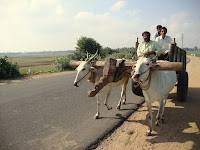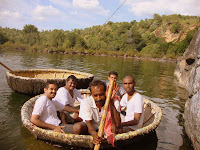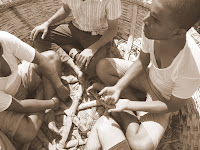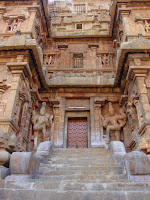It was Thursday (still 2 more days for the always awaited weekend!), all my office colleagues were too busy fire fighting with the errors/bugs/escalations in their cubicles! We bumped at each other in the pantry and one of them just asked 'So, whats the plan this weekend?'. With a sad face, i said 'Nothing, will stay at home'.
Comes Friday and the office looks colorful and all smiles on people's faces. The cubicles almost gave a deserted look by 10 pm (10 pm is still our mid-day since we work on north-american shifts). It was 1:00 am and my team & I were still glued to the system and a conference call working on a critical issue. My friends passed by asking for help & shared their idea to go to Talakkadu & Shivanasamudra early Saturday morning and that they have hired a vehicle too. I was happy and agreed with a feeling that i would leave by 2:30 and could catch few hours of sleep before we all meet just after dawn.
All my calculations went wrong when the issue-resolution got further delayed and i had to leave at 3:40 am. My friends stayed back too with me in office to help me out. We departed for home, no one slept (if we did, we will not wake up!). I was picked up at Uttarahalli circle enroute Kengeri(Mysore road).
We soon hit the mysore highway, had hot tasty thatte idlis and coffee.
Taking a left after Maddur, we reached Malavli and headed towards Talakkadu. The road was okay for few kms but deteriorated as we passed by the villages within.


We could see traffic on the mysore road, but towards Talakkadu traffic was almost zero except the bullock-carts and tractors.
We reached Talakkadu Cauvery river bank at around 9:30. The story behind the sands seen on this river bank is very interesting. We were reminded of the stories that an old granny narrates to her grand-children, full of Gods and daemons, curses and boons, kings and queens. It did not sound fantasy to us since we could see all that there while we hear the history behind those. At the first sight, you would mistake this to be a usual picnic spot, but to get to the roots and know the secrets of this place, you should walk & explore around. and whats different is, you walk more on sand and less on cement/tar-roads.
Talakkadu was ruled by the Ganga dynasty, then Cholas (of Tamilnadu), the Hoysalas and then Vijaynagar kings. The Wodeyars of Mysore declared war, the soldiers were sent to take away the jewels of Alamelama (widow of the late viceroy). As she fled and jumped into Cauvery, she cursed that this place be buried under sand and the Wodeyars be deprived of heirs to their throne.



After years and decades of being buried under sand, the Archeological dept started excavating this land and have unearthed so many temples that talks about the different dynasties that ruled this land. The localities believe there are still hundreds of temples that may still be buried deep inside.
Talakkadu is famous of its Pancha-Lingas (5 lingas of lord Shiva that were excavated). They are Paathaleshwara, Maraleshwara, Aarkeshwara, Vaidyanatheeshwara and Mallikarjuna.






the architecture of each temple clearly speaks of the different dynasties who built them. The beauty is that - all these different temples and monuments were not built by just One emperor. The Maraleshwara temple depicts the Chanakeshava temple of Belur(near Hassan), few temples depict Tamilnadu style gopurams.
The villages nearby had lonely streets, the main source of income here is tourism, small food stalls, boating, etc...


This place is approx 130 kms from B'lore. We left Talekkadu at around 11:30. Of course not alone, but thoughts hovering in our minds and all those nostalgia. The climate outside was good, the sun was getting hotter and that was a perfect time to cool ourselves under the waterfalls! We were heading to Shivanasamudra, around 40 kms from Talakkadu. Just about to leave Talakkadu, We had ice creams (did not count how many, but the vendor said he had to go back home to re-fill his stock!)
Our decision to have lot of ice-creams proved right as we did not see a single food stall enroute Shivanasamudra. We finally touched a junction that showed Gaganchukki to the left and Bharachukki to the right. We took left and entered a small Muslim township. There is a Dargha and just adjacent to it is a watch tower that gives an awesome view of the entire valley But there was no water flowing down at Gaganchukki falls. My friend Subhash and I being photography lovers were disappointed. We walked along the huge stones to site something (just hope) and to our dismay, there was none. Our faces turned red and assumed the same would be at Bharachukki. We headed to Bharachukki and as we were about to reach, smiles were back when we saw not one but many falls gushing from meters above into the deep valley. We quickly changed dresses and walked down the steep stony steps to reach the bottom of the falls.


We went into the shallow waters near the falls, the constant gushing sounds of the water added to the excitement, the sun was hot and the water was cold - perfect combination! We did not venture into any adventurism like most of the other youngsters. There were rocks and stones beneath and you need to be very careful and well-balanced while you walk or even stand since the rocks are slippery and you could land into "troubled-waters" if you do not have a helping hand and do not know smimming! You also need to take care of the glass pieces because of people carelessly throwing the emptied alchohol bottles here and there.


We next hired a corocle (or theppa) boat to experience another adjacent falls. The deal was Rs. 100 if you wanna just go and visit the falls, Rs. 200 if you would be taking bath under the falls!.. We could not press the buzzer and say 'No-Deal'! we had to go for it..





the wonderful experience & cool water showers falling on us was more than enough to set our minds free and forget all those annoying issues/bugs/escalations!!
Rs. 200 full wasool!!




We thoroughly enjoyed the falls having spent almost 4+ hours there!.. no wonder we were all terribly hungry. One of my friends opted to have a fish fry while rest of we 4 had some cucumbers and water melons.
We left Shivanasamudra and captured some breath-taking snaps of the beautiful valley around on our way back.






Just as we touched the highway towards Kanakpura to return back to Bangalore, it was just 5:15 pm. We were now 90+ kms away from home and saw a small hotel (kind-of) at some cross-roads of a remote village named Sathanur. The aroma of dosas and coffee was so tempting that we barged into it. We ordered for Benne-dosa(butter dosa), tea, coffee. It was very tasty and filling. The rates were too nominal.
We hit the road again and saw a diversion to Muthathi river which was 20 kms away. We still had time and so decided to go to Muthathi. We drove through the some hills and wilderness of Cauvery Wildlife Santuary, the roads went through Bheemeshwari and Cauvery Fishing Camp. There were sign boards saying that you could spot Leopards, Cheetahs etc. We spotted a fox waiting to cross the road.. Our eyes were wide open and we looked at both sides if we could spot more until we reached the river side, we could not find any other wild animals on the way. Muthathi is a very peaceful and you could only 'hear silence' all the time. It was getting darker, we managed to capture some snaps though.
What we did miss to capture was the sunset. But no worries, we managed to capture some good snaps even in the twilight.. the sun had left its trail.. thereby saying Goodbye to a wonderful day..


Hope you all too had a wonderful journey with me by reading my first travel-blog... Pls leave your valuable comments. Happy to help you in case you need more details on these places. Watch out for more travel articles on this space...
Love,
Ananth [arun.cf@gmail.com]




































































